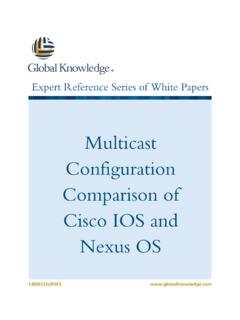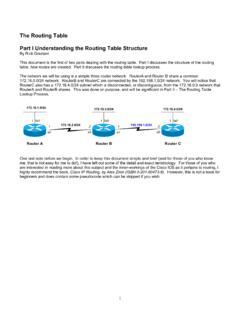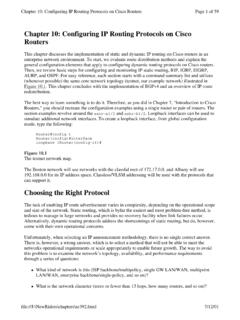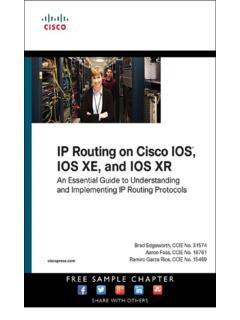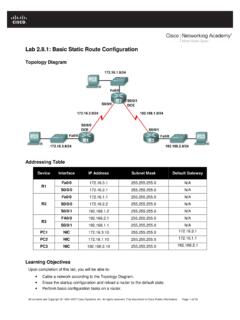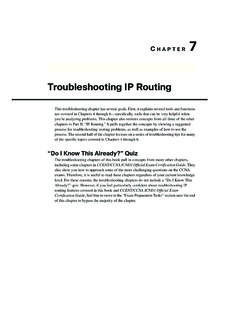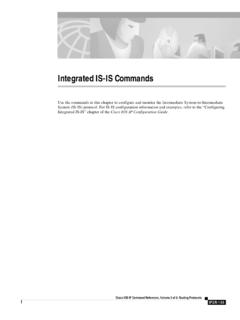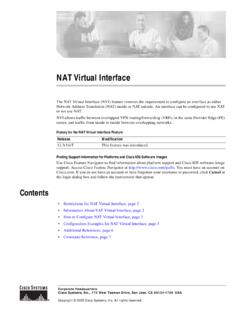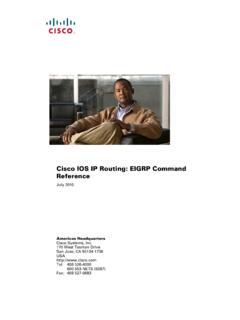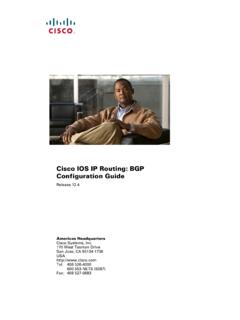Transcription of CCIE Routing and - pearsoncmg.com
1 ccie Routing and Switching ReferenceTable of ContentsChapter 1 General Networking Theory ..2 Chapter 2 Bridging and LAN Switching ..11 Chapter 3 IP Addressing ..30 Chapter 4 IP Routing ..55 Chapter 5 Quality of Service (QoS) ..113 Chapter 6 Network Optimization ..144 Chapter 7 WAN ..157 Chapter 8 IP Multicasting ..168 Chapter 9 Security ..185 Chapter 10 MPLS ..204 Chapter 11 IPv6 ..217 Chapter 12 Implementing Layer 2 Technologies .226 Chapter 13 Implementing IPv4 ..232 Chapter 14 Implementing IPv6 ..241 Brad EllisJacob UeckerSteven [ 144 ] 2011 cisco Systems Inc. All rights reserved. This publication is protected by copyright. Please see page 245 for more Routing and Switching Quick ReferenceChapter 6 Network OptimizationIP Service Level Agreement (SLA)One of the most important aspects in maintaining a network is providing a guarantee of a specific level of service to custom-ers.
2 To ensure that such an agreement is met at all times, IOS provides a mechanism to actively test specific metrics, called IP SLA. When configured, the IP SLA service actively monitors a specific aspect of the network, such as UDP VOIP jitter, DNS response time, ping latency, and so on. If the IP SLA thresholds are not met, IOS sends a notification, such as an SNMP trap or syslog create a basic IP SLA monitor, the type, options, and frequency must be specified. After the monitor has been created, a schedule is build that kicks off the monitor. To monitor the round-trip response time between a router and an IP, you can use the ICMP Echo Operation:Router(config)# ip sla monitor <OPERATION #>Router(config-sla-monitor)# type echo protocol ipIcmpEcho <DESTINATION>Router(config-sla-monitor)# frequency <SECONDS>Router(config-sla-monitor)# exitRouter(config)# ip sla monitor schedule <OPERATION #> [life {forever | seconds}] [start-time {hh:mm[:ss] [month day | day month] | pending | now | after hh:mm:ss] [ageout seconds] [recurring]Some monitors require that a responder be configured (UDP Jitter, UDP Echo, and TCP Connect) on one router:Router(config)# ip sla monitor responder[ 145 ] 2011 cisco Systems Inc.}
3 All rights reserved. This publication is protected by copyright. Please see page 245 for more Routing and Switching Quick ReferenceFollowing are other IP SLA monitor operations:UDP Jitter: type jitterVOIP Jitter: type VOIP Gatekeeper Delay: type voip delay gatekeeper registrationUDP Echo: type udp echoHTTP Connect: type http operationTCP Connect: type tcpConnectICMP Echo: type echo protocol ipIcmpEchoICMP Path Echo: type pathEcho protocol ipIcmpEchoICMP Path Jitter: type pathJitterFTP Operations: type ftpDNS Operations: type dnsDHCP Operations: type dhcpNetFlowAs packets are sent through router interfaces, they can be classified into flows. This information can be sent from the router to a monitoring server that can provide valuable information about the traffic traversing the network. A flow can be described by a number of fields: n Source IP address n Destination IP address n Source port n Destination port n Protocol type n Type of Service n Interface[ 146 ] 2011 cisco Systems Inc.
4 All rights reserved. This publication is protected by copyright. Please see page 245 for more Routing and Switching Quick ReferenceTo determine if a packet belongs in a particular flow, the seven packet fields are inspected. If any one of the fields is different, the packet in question can be considered a new flow. NetFlow statistics can be collected on the following types of networks: IP, Frame Relay, MPLS, and ATM. To enable NetFlow on an interface, the ip flow command set is used. To configure NetFlow on an interface:Router(config-if)# ip flow ingressEgress support can also be added:Router(config-if)# ip flow egressTo configure the router to export the NetFlow data to a NetFlow serverRouter(config)# ip flow-export {destination {ip-address | hostname} udp-port | source {interface-name} | version {1 | [{5 | 9} [origin-as | peer-as] [bgp-nexthop]]} | template {refresh-rate packets | time-out-rate minutes} [options {export-stats | refresh-rate packets | sampler | timeout-rate minutes}]}To be exported to the NetFlow collection server, the flow must have been exported from the flow cache.
5 Active flows (when there is an ongoing conversation) live for 30 minutes by default before they are exported. Inactive flows, those that have been terminated, are sent after 15 seconds. These values are configurable:Router(config)# ip flow-cache timeout [active minutes | inactive seconds]The number of flows that can be collected can be modified with:Router(config)# ip flow-cache entries <#>SPAN, RSPAN, and Router IP Traffic Export (RITE)Viewing the packets between two devices is often the best way to troubleshoot a networking issue. Many organizations deploy network monitoring servers for both network functionality and security purposes. To provide these servers a stream of data from all segments of the network, the Switched Port Analyzer (SPAN) mechanism built into cisco switches can be used. A SPAN port is a physical port that is configured to send data received on other ports or VLANs.
6 When the data is sent out the SPAN port, it is simply a copy of all the data that has been sent through the configured source ports. To configure the source of the data to be sent out the SPAN port[ 147 ] 2011 cisco Systems Inc. All rights reserved. This publication is protected by copyright. Please see page 245 for more Routing and Switching Quick ReferenceRouter(config)# monitor source <#> source {interface interface-id | vlan vlan-id} [, | -] [both | rx | tx]Either a source interface or entire VLAN can be specified. You can use the command multiple times with the same session number if multiple sources are configure the destination of the data to be sent:Router(config)# monitor destination <#> destination interface <INT>The data received in the source interface is sent to the specified destination SPAN functionality assumes that the destination of the traffic is directly connected to the switch.
7 If the network is large, it might not be possible to wire a single monitoring station to multiple switches with SPAN ports. Fortunately a special remote SPAN (RSPAN) VLAN can be created that transports the SPAN port information to another switch. This enables an aggregation of monitoring data into a single VLAN that can be sent to the monitoring configure the RSPAN VLAN, the remote-span command must be specified within the VLAN configuration mode:Router(config-vlan)# remote-spanSpecify the destination of the SPAN port as the remote-span VLAN:Router(config)# monitor session <#> destination remote vlan <VLAN>This is great for switches, but is there a similar technology for a router? Yes! The Router IP Traffic Export (RITE) mechanism can export traffic to specific devices defined by the MAC address. To configure, a RITE profile is created and then it s applied to an interface.
8 The traffic that RITE applies to can be limited by configure the profileRouter(config)# ip traffic-export profile <PROFILE NAME>Specify the outgoing interface:Router(config-rite)# interface <INT>Specify the MAC address to send the traffic to:Router(config-rite)# mac-address <MAC>[ 148 ] 2011 cisco Systems Inc. All rights reserved. This publication is protected by copyright. Please see page 245 for more Routing and Switching Quick ReferenceSpecify whether bidirectional traffic is necessary. Without this command, only packets incoming to the router are sent:Router(config-rite)# bidirectionalOptionally, ACLs can limit the traffic sent:Router(config)# incoming {access-list {standard | extended | named} | sample one-in-every packet-number}Router(config)# outgoing {access-list {standard | extended | named} | sample one-in-every packet-number}Apply the RITE policy to an interface:Router(config-if)# ip traffic-export apply <POLICY NAME> cisco IOS Embedded Event Manager (EEM)In the normal operations of the switch or router, events such as a CLI command, a syslog message, or an SNMP trap, for ex-ample, are constantly occurring.
9 These events are detected by the EEM Event Detectors that send their information to the EEM server. The EEM server can then be programmed to implement an EEM policy. The two different types of EEM policies are ap-plets and TCL scripts, which can be programmed to perform a variety of tasks, such as send syslog messages and SNMP traps, fire off emails, and even open raw applet can be configured directly within the IOS CLI by first creating a policy and registering it:Router(config)# event manager applet <APPLET NAME>The applet must be configured to detect a specific event. There are a number of different event detectors, each with their own syntax:Router(config-applet)# event <EVENT DETECTOR> n application: Application-specific event n cli: CLI event n counter: Counter event n interface: Interface event n ioswdsysmon: IOS WDSysMon event[ 245 ] 2011 cisco Systems Inc.
10 All rights reserved. This publication is protected by copyright. ccie Routing and Switching Quick ReferenceCCIE Routing and Switching Quick ReferenceBrad EllisJacob UeckerSteven Means Technical Editor: Scott MorrisCopyright 2011 cisco Systems, by: cisco Press800 East 96th Street Indianapolis, IN 46240 USAAll rights reserved. No part of this book may be reproduced or transmitted in any form or by any means, electronic or mechanical, including photocopying, recording, or by any information storage and retrieval system, without written permission from the publisher, except for the inclusion of brief quotations in a Printing September 2011 ISBN-10: 1-58714-163-9 ISBN-13: 978-1-58714-163-8 Warning and DisclaimerThis book is designed to provide information about the ccie Routing and Switching written exam. Every effort has been made to make this book as complete and as accurate as possible, but no warranty or fitness is information is provided on an as is basis.










